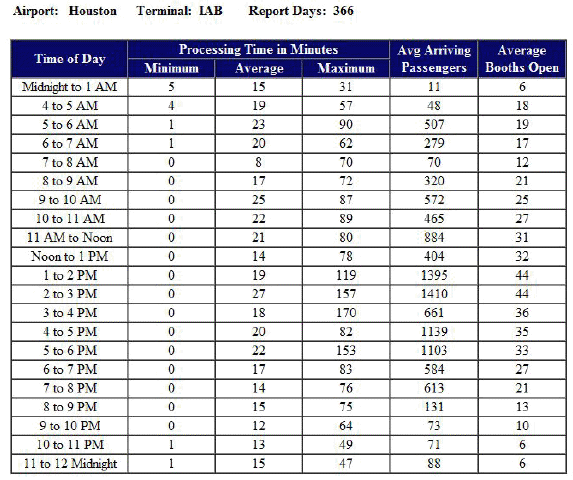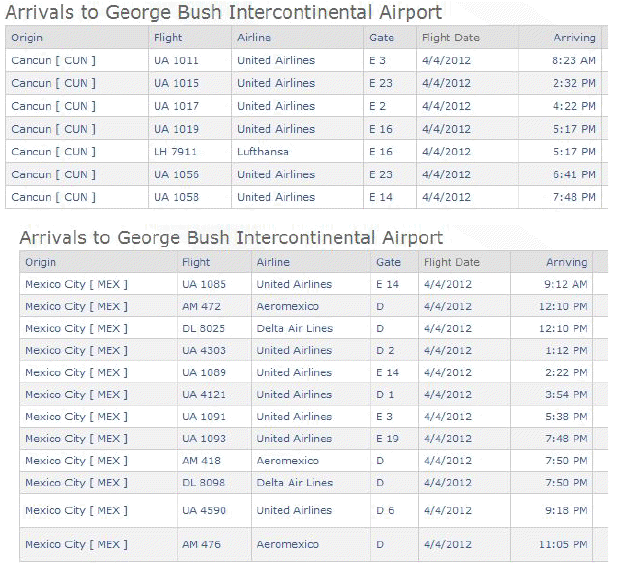Today’s the day when we get that report from Houston Airport System Director Mario Diaz that makes a recommendation to Mayor Parker and City Council about whether or not to expand Hobby Airport to include international flights. We will also get those two economic studies the city paid for to quantify the effect of such a decision. As we know, Southwest says greenlighting the expansion will be an economic jobs-creating boon for Houston, while United says just the opposite. In a Friday editorial, the Chron leans in Southwest’s direction.
Our call on this issue proceeds from the answer to a straightforward question: What is best for Houstonians and their city’s future? That is the question we expect to be uppermost in Houston City Council members’ minds as they deliberate this matter – well ahead of small-bore political considerations such as which party has ponied up how many dollars in campaign contributions or fund-raisers and the like. This is an issue with large regional implications and should be so addressed by council and Mayor Annise Parker. There are no home teams to favor in this.
As a general proposition, we believe the skies over Houston are big enough for both of these airlines to grow and prosper. And we believe that the future of this city and region is even bigger than the wild blue yonder they both call home.
That inclines us to favor welcoming Southwest’s entrepreneurial plan to expand Hobby at its own expense.
It’s hard for me to see how that’s not the right call. United’s argument largely boils down to a claim that you can only expand international travel at IAH, which in addition to being intuitively questionable also fails to hold up under a closer look at the numbers. To that effect, I presented another analysis of the situation by my wife, Tiffany Tyler. I’m reprinting that here today, partly because it was at the end of a long post on Friday and people may not have gotten to it and partly so I can link to her LinkedIn profile so you can get some idea of what her professional creds are. Here it is again:
First, thanks to all who responded favorably to my previous guest post. And yes, it’s been more than a weekend since I promised to write a follow-up. Unlike my spouse, I’m not conditioned to getting up at 5 am daily to create blog content, so it took me a while to work this in.
I’ve been reading with interest the “debate” around whether or not creating an international terminal at Hobby would be dilutive to the US Customs presence at Intercontinental. I’ve seen numerous comments from people saying things like, “the lines are too long at IAH as it is, this will only make it worse! They’ll take agents away!”
This got me thinking about the real numbers involved in the lines at International arrivals. Basically, it’s a function of how many people are getting off the plane at once. A busy airport like IAH has multiple flights coming in at the same time, especially when long haul flights from Europe and Asia arrive. An international terminal at Hobby would, at least in the beginning, have a much smaller number of flights and no 747s dumping 450 people at a time on Customs and Border Protection. Do the math:
The proposed Hobby scenario is 25 flights a day at 5 gates. The average capacity of a 737 in the Southwest fleet is 137 people. Southwest flies ONLY 737s. Even if they added the biggest, baddest 737 out there to give themselves greater range or capacity, they will top out at about 180 passengers. So 25 flights a day, spread over 10 hours – we’ll be generous and say 3 flights an hour, then round up capacity and say 500 people an hour through customs at Hobby, closer to 600 if they go with new 737-900ERs. This number is too large, in any real sense, but keep it in mind as we continue our mental math.
Compare that to IAH, where United and all of the other international carriers land something like at least twice that number of flights an hour (peak times when long haul flights come in from Europe or Asia) with an average capacity of a 747 or a 777 at 450 passengers PER PLANE. Look at the data, which I have taken straight from the Customs and Border Protection website, which can generate this handy table for any date range you select. This one is for 1 January 2011 to 1 January 2012.
So at peak times, Border Protection sees an average of 1100 or more people an hour through IAH. That makes our 500 passengers an hour through Hobby seem crazy-big. But stay with me. The data from CBP can’t be cut by day of the week, so I can’t tell if it’s appreciably worse on certain days. I’ve been on enough overnight flights to be leery of the low averages between 8 and 10 am, for instance. If you look at just 2 of the arrival schedules for cities in question with the proposed Southwest expansion, Mexico City and Cancun, as pulled from the handy schedule tool at http://fly2houston.com/:
You can see that United doesn’t bring in more than one 737 from either departure city before noon (at least on a Wednesday, the day I pulled the data). The majority of the flights come in during those peak average hours on the CBP chart. So it’s unclear to me that taking some passengers OUT of those IAH averages would be a bad thing. Given that the IAH Master Plan for 2011 (the last one available on their website) is estimating a 3.9% annual growth rate in international travel alone between now and 2015, and diversion of traffic from Cleveland when United (probably) draws down that hub in favor of Chicago, it seems to me there is still PLENTY of growth going on at IAH to sustain demand for international flights, even if you add a potential 500 passengers an hour that could go through Hobby instead.
The advantage I’d see for potential international travelers at Hobby, and frankly for CBP as well, is that at least in the short run, Southwest would be the only international carrier at Hobby, and for that length of time, the average number of passengers coming through per hour would be highly predictable and consistent. That would make staffing easy to model, and certainly have a smaller swing from valley to peak than they have at IAH. As a traveler, I’m having a hard time seeing a downside with this.
The funding mechanism for Customs agents has always seemed opaque to me. On the one hand, United is claiming that IAH is already understaffed and opening Hobby would take agents away form IAH. This presumes the number of customs agents in a city airport system is a zero sum game. Of course United also contended that they didn’t have an issue with Southwest flying internationally as long as they do it out of IAH, which as I’ve shown above is absolutely silly in terms of wait times for the passengers. If they could add more agents to IAH to handle that added traffic, why couldn’t they add agents at a new airport, making passengers at IAH no worse off, and possibly with an improved option for lower fares and reduced customs wait times at Hobby relative to IAH?
This all presumes that new aircraft types don’t drastically change the throughput of arrivals in the IAH customs hall independent of anything Southwest might or might not do, of course. Surely United wouldn’t be planning to add more folks to what is already an overcrowded CBP system, right? That’s what they’re trying to protect us all from! And yet, look at the data. According to Boeing’s order book, the old Continental ordered 25 787s and United ordered 25. It’s true that I can’t tell where these planes are INTENDED to go in the United Route system, or even if those 50 orders are still “firm” in Boeing’s books, but think about it for a few minutes. This aircraft is slightly larger than the 737 (210-290 passengers, depending on configuration), with a range suited for flights between, say Houston and Delhi, India. Imagine the customs issue at IAH when you add 75 extra people per flight.
But you might be more concerned about the Airbus order book. The A380 holds 525 passengers. Imagine IAH at peak hours with 525 people on each of the BA, Air France and Emirates flights and not the 450 currently on a 747. You won’t have to wait long to see what it will feel like. Lufthansa is bringing the A380 to IAH beginning this August, and that Frankfurt flight lands at about 2 pm, right before a number of those United flights from Mexico.
Color me skeptical about United’s position generally. They may lose some customers, and cut some flights, in response to Southwest opening international service. But even with the newest, longest range 737s, it’s still a 737. And that “fleet commonality” is a huge part of what makes Southwest able to do what they do to control costs. Trust me here, I wrote a doctoral thesis on it. For United, as for American and AeroMexico, the overall risk of passenger loss will go up over time as Southwest expands their schedule past the currently proposed 5 city pairs. But those airlines, with their diversified fleets and deeper, longer route structures (at least for the US-based carriers), will still have plenty of places to go that Southwest can’t get to in a 737, and passengers want to go those places. I find the Customs and Border Protection argument disingenuous, given the pressures already in the customs hall and the growth projections that are already part of the IAH Master Plan and the fleet growth plan of United, insofar as I can guess what it is from the Boeing order book.
It’s the customers who have the most to gain from a Hobby expansion gateway. And as a customer, I’ll bet on Southwest working in my interest before I’ll bet on the “new” United.
Thanks again to Tiffany Tyler for that in depth analysis. And now we wait to see what Mario Diaz has to say.



Pingback: Air Battles « Camposcommunications’s Blog
CBP creates their own understaffing issues. How many agents are sitting in the badging office @ IAH daily? They have created lots of job security by harassing airline employees on badge renewals & background checks. It’s taken several employees weeks to months to get badges renewed. That means time lost @ work with no pay. CBP does our background checks annually now when previously it was every other year. Either way if you don’t have anything on your record that is from the previous renewal what seems to be the problem????? 20 + year employees still losing work due to this type of harassment!!! All at the taxpayers expense!! So yes, I find it very hard to believe that this is even an issue (moving CBP agents to other facilities) when our govt is wasting time & money with the badging office.